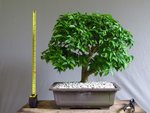Deep Sea Diver
Imperial Masterpiece
It will be real in our lifetime!
Cheers
DSD sends
Cheers
DSD sends
Last edited:
I'm sure of that. All that's needed is one or more scientists to set the ball rolling...similar to what Karen O’Haren is doing with this product. The demand is there...horticulture is already the future.It will be real in our lifetime!
Cheers
DSD sends
Ya know how I hate to be picky, but if we look back a few years to when somebody thought it would be a good idea to add German Brown Carp to American fish stocks, or rabbits in Australia, or hundreds of other really bad ideas, -too many to list, we find that those really good ideas had consequences. Irreversible consequences. Beware of what you wish for.How fantastic will it be, if we had a natural biological product that we add to our inorganic soil to aid us in our war against pathogenic fungi?
It must be THE biggest problem I gauge on this forum....What is this fungis and how to get rid of it...? Thread after thread after thread about maple leaves for instance...!
Nah you're not being picky at all. I'm with you about species forced to live outside their native environment. That is another cruel deed man dealt on animals.Ya know how I hate to be picky, but if we look back a few years to when somebody thought it would be a good idea to add German Brown Carp to American fish stocks, or rabbits in Australia, or hundreds of other really bad ideas, -too many to list, we find that those really good ideas had consequences. Irreversible consequences. Beware of what you wish for.

Here’s an idea, leave a couple trees untreated and catch their water about a week after you treat the others. Then include this water when watering the others for a week or so. That might help the lil guys bounce back.
ButWe're doing the same with trees. And we're bummed that nature always wins.
As if olives and pomegranates have any issues growing here. My own pomegranate flushes three times a year.But
But
But..
I like pomegranates
I like olives
I @Clicio s trees in the rain..
I LOVE jabuticaba..
Now what?
In the Biblical sense I think you are straining at a nat and swallowing a camel.Yeah, I know that older growers have amazing trees that showcase their bonsai abilities, but I also understand that even many masters in Japan use a veritable TON of chemicals (both chemical fertilizer and chemical pesticides/fungicides) to maintain their trees. I'm looking to go more organic, even if it means foregoing the level of bonsai stardom of my dreams.
Of course, there are some older (and newer!) practitioners--perhaps you're one of them?--that insist on an organic model of feeding and disease prevention. I'm all for it. As a newbie, though, I couldn't find anything specifically addressing how to grow strong, "good" fungus in modern substrate, since, as I said, so many enthusiasts just assume they're going to be blasting their trees with chemicals.
Not sure I follow you.In the Biblical sense I think you are straining at a nat and swallowing a camel.
Mycorrhizal fungi get what they need to grow from the plant, it’s symbiotic. They do just fine in coarse inorganic substrates as long as there is also some kind of plant roots growing there. Bacterial populations can explode very quickly, an organic feed will have them multiplying away like mad in a modern substrate.

I am working,but this product starting working instantly ....better so in organic fert ,open soil.I think you're right that modern substrates do support microbial/fungal life, but I also came across this quote from a scientific article, which seems to suggest that inorganic, soilless substrates do not support microbial/fungal life to the same degree as regular soil. If you have any sources on this subject, please send them my way--I find the subject fascinating.
"Microorganism population differ significantly between soilless culture systems and the indigenous microorganism type in each soilless system is unique. Organic (coconut-fiber) soilless substrate system had the highest amount of fungi and Fusarium spp., whereas the inorganic substrate (rockwool) contained the highest amount of fluorescent pseudomonads. In addition, aerobic bacteria could be dominant over fungi in inorganic (rockwool) substrate. Soilless substrates lack the diverse biological and microbial communities found in conventional agriculture soil. For soilless culture, a few studies have assessed the usefulness of inoculating plant with microorganisms at early stages but none of them showed a significant positive impact on cultivated crop."

(PDF) SOILLESS CULTURE: MANAGEMENT OF GROWING SUBSTRATE, WATER, NUTRIENT, SALINITY, MICROORGANISM AND PRODUCT QUALITY
PDF | The present article reviews the scientific literature on soilless culture and provided a critical examination of the micro-environmental factors... | Find, read and cite all the research you need on ResearchGatewww.researchgate.net




 www.xtreme-gardening.com
www.xtreme-gardening.com
I am working,but this product starting working instantly ....better so in organic fert ,open soil.
I tree I used to own.......I over applyed the product and it actually became a bit aggressive....thread is here somewhere.
View attachment 319142View attachment 319143View attachment 319144
